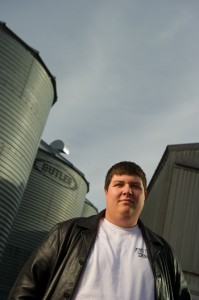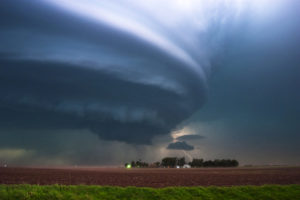Inside the Storm
Most of us run from violent weather. Storm chasers hope to get as close as they can, then live to tell about it.
By Susan Fotovich McCabe
The 1996 Hollywood blockbuster Twister provided movie audiences with a hair-raising account of tornadoes whipping across farm fields and ripping through drive-in movie theaters.
But not even Hollywood can do justice to the true, destructive nature of a funnel cloud … or the thrill of chasing one.
Despite the deadly potential of tornadoes, numerous people—professionals and amateurs alike—actually pursue this ugly byproduct of Mother Nature’s fury. Instead of running for cover like most of us, they spend days, sometimes weeks on the road hunting storms like so much deadly prey.
Whether thrill seekers or researchers on the edge, most of these so-called “storm chasers” hope to further science in hopes of better forecasting violent weather events and protecting us all from them.

Gabrielson picked up a fascination with storms while living in southwest Minnesota on the family farm, where his folks just happened to run a Massey Ferguson tractor. Photo by Greg Latza
Professional chaser and videographer Andy Gabrielson experienced his first tornado at the age of 7 on his family farm in Luverne, Minn. “We were driving toward the river to watch the rain, and as we came down the hill, we saw a stove pipe—or cone tornado—coming right toward us,” he says. “We were only a short distance from our house, so we ended up heading home and watching from our bottom floor. When it got within about a mile, it headed the other way and dissipated.”
He was hooked immediately. “After that, when I was at school, I would always go to the library to check out books on tornadoes,” continues Gabrielson, whose videos and photos of news-making twisters have since appeared on NBC’s The Today Show. By high school, he was taking storm spotter training classes and chasing storms with the aid of a paper map and a weather radio.
Today, Gabrielson, who is working toward a business degree at Colorado Technical University in Colorado Springs, pursues his passion with about $40,000 in equipment, including his specially equipped SUV, digital video and still cameras, and a dash-mounted laptop loaded with weather-detection technology. The 23-year-old covers those costs by working on the family farm and selling his photos and videos (see Andy’s video pages for more information).
Typically, he chases storms between early April and late June, planning ahead for a chase by watching forecast models and choosing to track what he believes are the most promising predictions for tornadic activity. “That’s when I head out,” he says, hitting the road for weeks at a time.
Often, predictions prove to be false alarms, or, for Gabrielson, broken promises. Yet, when the weather does appear to be cooperating, he plays the waiting game, often sitting in his vehicle—on the side of a cornfield, on the edge of town, or in whatever location offers a good vantage point—for hours on end. “I usually make a habit of getting into position early, or I risk missing something,” he says. “If we get in on the right storm, you can actually watch the tornado drop to the ground.”
Despite having witnessed about 100 tornadoes during his 3-year storm-chasing career, Gabrielson says he’s only really experienced “danger” up close once. When tracking a nighttime storm in Dupree, S.D., he didn’t realize how close the funnel cloud actually was, due to the dark skies. One touched down just 15 yards from where he was and actually picked up the back end of his SUV. “That was probably the most ‘slightly’ frightening moment I’ve had,” he says, chuckling at the memory.
While chasing a tornado provides Gabrielson with an adrenaline rush, he believes it’s helping to further research on the subject. Specifically, Gabrielson says the National Weather Service often uses his photos and videos in storm spotter training classes.
Thrills, however, are still a big motivator, even when they come for less-than-obvious reasons. “Even though I have all this technology,” says Gabrielson, “I have to say I started out with virtually nothing and I like the philosophy many older storm chasers have, which is when you find a tornado on your own, it’s so exhilarating.”

John Schroeder and his band of Texas Tech graduate students hit the road for weeks at a time to research storms. Photo by Karl Wolfshohl
John Schroeder doesn’t like to be called a storm chaser. For him and the small army of scientists he helps direct, it’s all about the data.
Schroeder is an associate professor of Atmospheric Science in the Department of Geosciences at Texas Tech University in Lubbock and director of the school’s Wind Science and Engineering Research Center (WISE). It’s through their work at the center that Schroeder and his colleagues and students collect and study detailed information about wind flow in the lowest layer of the atmosphere. They do so for all types of weather-related events, including tornados, hurricanes and thunderstorm outflows. “We are working towards understanding the structure of the low-level atmosphere, which directly impacts society,” says Schroeder. (For more about WISE, see link at right.)
Over the last 2 years, Schroeder says he and his graduate students have “traveled nomadically” for periods of 6 weeks at a time to study, not chase, weather throughout the Midwest and beyond. “As scientists, we’re not as concerned about the thrill of it, but in getting a good data set to advance the science. The sole purpose of our research is to develop a fundamental understanding of storms and storm structure,” says Schroeder. “If we don’t understand why one storm produces a tornado and why another right next to it doesn’t, we’ll never be able to forecast them.”
In the last decade, Schroeder says, “research has indicated the difference between a non-tornadic and a tornadic storm may be very subtle and localized. Hence, local measurements around storms are needed to advance the science to the next level.” That means that researchers at WISE and similar institutions need to place data-gathering devices next to or, better yet, in a storm. And while Schroeder may not be in the business for the thrills, such work has admittedly led to some adrenaline-infused moments.
One of them occurred just outside of Hill City, Kan., in 2005. Schroeder and his team deployed four cars full of gear, just to the south of a twister. At about a half-mile from the actual tornado, he was in the car closest to vortex, getting clobbered by quarter-sized hail, blown by 100-mile winds. “The wind shook the car,” remembers Schroeder, “but the sound of the wind-driven hail beating on the windows is what really got your attention, not to mention the tornado passing nearby to the north.
“I’ll be honest. The situation was intense, but I remember verbally saying, ‘We are sitting in the perfect spot.’ We were focused on acquiring a great data set, because you just don’t get that many opportunities.”
The information collected was valuable, but Schroeder dryly says he has no desire to be any closer, noting his team has developed and uses new, unmanned instrumentation platforms, so they can deploy the instruments, take shelter and watch from afar. Still, he says, the last instrument drop is often made with a tornado just a mile away.
“We tell students that while going out, chasing and seeing a tornado might be thrilling,” says Schroeder, “we want them to collaboratively work with other students to deploy equipment under the duress of a storm. By the end of a project, we hope they understand that it’s all about them developing to be a good scientist. By the end of a season, I want them to say they wish they had one more chance to gather a good data set.”

Thompson is tasked with monitoring wind gusts, hail size, rainfall and cloud formations that could signal a developing tornado. Photo by Dan Donnert
Keeping Watch
Rob Thompson has no desire to chase storms. Unlike Andy Gabrielson, an early brush with tornados was enough to last this Ada, Kan., resident a lifetime. Still, Thompson is a volunteer for the National Weather Service’s SKYWARN program. Developed a little more than 40 years ago, SKYWARN positions weather spotters in communities across the country to collect and share weather-related data.
Armed with a $90 weather data-gathering station he purchased himself and what he calls a “fancy rain gauge” supplied by the National Weather Service, Thompson is tasked with monitoring wind gusts, hail size, rainfall and cloud formations that could signal a developing tornado. Thompson, who is a salesperson for Lincoln Farm Supply, a Massey Ferguson dealer in Lincoln, Kan., also has a 240-acre cattle and crop operation, and is a volunteer fire fighter.
SKYWARN does not refer to its spotters as “storm chasers,” nor do they encourage risk-taking while collecting data. Typically, SKYWARN spotters stick close to home. In fact, Thompson says that when he’s asked to report on snowfall, he simply has to look out his window to gather the data. As part of his volunteer commitment, Thompson attends a training class once a year and says he has access to as much of the National Weather Service’s resource material as he wants.
Speaking about his time as a weather spotter for the last decade, Thompson says he’s “never seen a cow fly by,” referring to a scene in the movie Twister, and describes the weather he’s tracked over the years as “boring,” at least mostly.
Thompson, who, as a teenager, witnessed tornados growing up in Kansas and Oklahoma, has reported on cloud rotations twice in 10 years, one of which became the tornado that hit the unincorporated area of Lake Row, Kan., in May of 2007, the night after a deadly twister hit the nearby town of Greensburg, killing 13 people. The Lake Row tornado killed one person.
“Everybody thinks that if you’re a weather spotter, you get to chase tornadoes,” says Thompson. “I’ve seen how ugly it can get, so I have no interest in doing that.”
The National Weather Service has 122 local Weather Forecast Offices, each with a SKYWARN warning coordination meteorologist. Training is conducted at these local offices and covers many subjects, including basics of thunderstorm development, fundamentals of storm structure, identifying potential severe weather features, how to report information and basic severe weather safety.
Classes are free and are about 2 hours long. To find out when a SKYWARN class will be conducted in your area, contact your local warning coordination meteorologist at www.stormready.noaa.gov/contact.htm.





